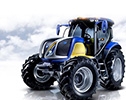Since 1895, New Holland is committed to providing solutions that improve farming efficiency and productivity by using accessible technology. In 2006, the Clean Energy Leader strategy was launched for the active promotion of renewable fuels, emissions reduction systems and sustainable agricultural technology. Rooted in the belief that farmers can use innovative solutions to free themselves from the constraints of fossil fuels, this strategy is based on four founding pillars: biodiesel, biomass, the ECOBlue™ SCR technology to meet the Tier 4 emissions standards, and the Energy Independent Farm and NH²™ hydrogen tractor.
New Holland offers cash crop producers, livestock farmers, contractors, vineyards and groundcare professionals the largest choice of easy-to-operate tractors, harvesters and material handling equipment: more than 80 product lines and over 300 models.
New Holland complements the widest agricultural equipment offering in the world with efficient Parts and Service support and a range of tailored financial services from a specialist in agriculture. An approachable and professional global dealer network always guarantees total assistance and expert advice season after season. Close to customers in all fields, New Holland is the reliable partner of each farmer.
The history of New Holland:
1895
Abe Zimmerman (Abe Zimmerman) organized a repair shop for farm machinery in New Holland, Pennsylvania, USA. In addition, in the same 1895 Brad Alexander (Alexandre Braud) introduced the farming community in Western France, the first stationary thresher.
1903
Zimmerman founded the New Holland Machine Company, specializing in the production of kormodrobilok and other means of mechanization of labor for the needs of the surrounding farmers.
1900s.
In the early 1900s, Henry Ford established the work of their auto plants in Detroit. They introduced mass production technology has revolutionized the automobile industry and opened the way for the organization of large-scale production of tractors.
1906
Belgian mechanic Kleys Leon (Leon Claeys) started manufacturing threshers. In 1909 he opened a functioning to this day engineering works in Zedelgem, Belgium.
1907
Ford introduced the world to "automobile plow," - the first prototype for the mass production of tractors with a gasoline engine.
1917
Start of production of "automobile plow" branded Fordson Model F in the factories of the newly established company Henry Ford & Son Company.
1918
A year later, with the assembly line of cars and trucks in Turin first tractor Fiat Model 702. This model won the international competition plowing in Sainlos (France). Model 702 is the first agricultural tractor brands Fiat, and the first mass-produced Italian tractor.
1930
For the large-scale introduction of tractors in national agricultural production Fiat founder Giovanni Agnelli Senator (Giovanni Agnelli) established cooperation with a number of Italian agricultural cooperatives.
1939
Ford has equipped tractors series N, which has become one of the most successful in the history of the world of tractors, three-point hitch type.
1947
Zimmerman founded the company changed its name to Sperry New Holland and came out with the first ever hay conditioner, significantly raising the level of mechanization of harvesting.
1950s.
In the late 1950s hFiat started production of two new models - Model 18 (known as the "La Piccola") and Model 18, through which the company has won wide popularity in the international market.
1960.
At desyatiletiepredpriyatie Kleysa become one of Europe's largest manufacturers of combine harvesters.
1964
Sperry New Holland Company acquired a large part of the business in the enterprise Kleysa.
1973
Start of production of the Fiat 640, which became the best-selling series "Nastro Oro". It is recognized around the world today.
1974
The conveyor Sperry New Holland came the world's first twin-rotor combine. It implements engineering concept continues to lead the segment productive harvesting machinery.
1975
Brad released his first grape-car named Model 1020. Its further development was in 1014, became famous as the most popular sweeper ever growing: in less than four years, she has found more than two thousand customers.
1970.
By the end of this decade, tractor-unit Fiat products are sold in 140 countries.
1980s.
Company Ford, offered the market a number of important innovations as hydraulics, pneumatic tires, diesel engines and three-hinged device, continues to be the leading player in the tractor market.
1986
Ford acquires Sperry New Holland, which leads to the appearance of Ford New Holland Inc.
1991
Group Fiat, which acquired the company Brada, becomes a holder of 80% of business Ford New Holland. The integration process is complete access to the market New Holland as a new brand in 1994, the merger of B New Holland and Case Corporation under the auspices of Fiat in 1999, the company became a structural unit CNH and has access to enormous resources to enable it to implement an aggressive policy update produced by the range and improve the quality of customer service to a new level.



